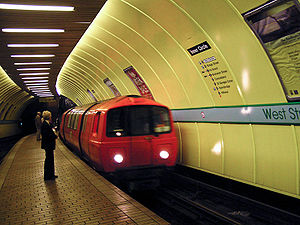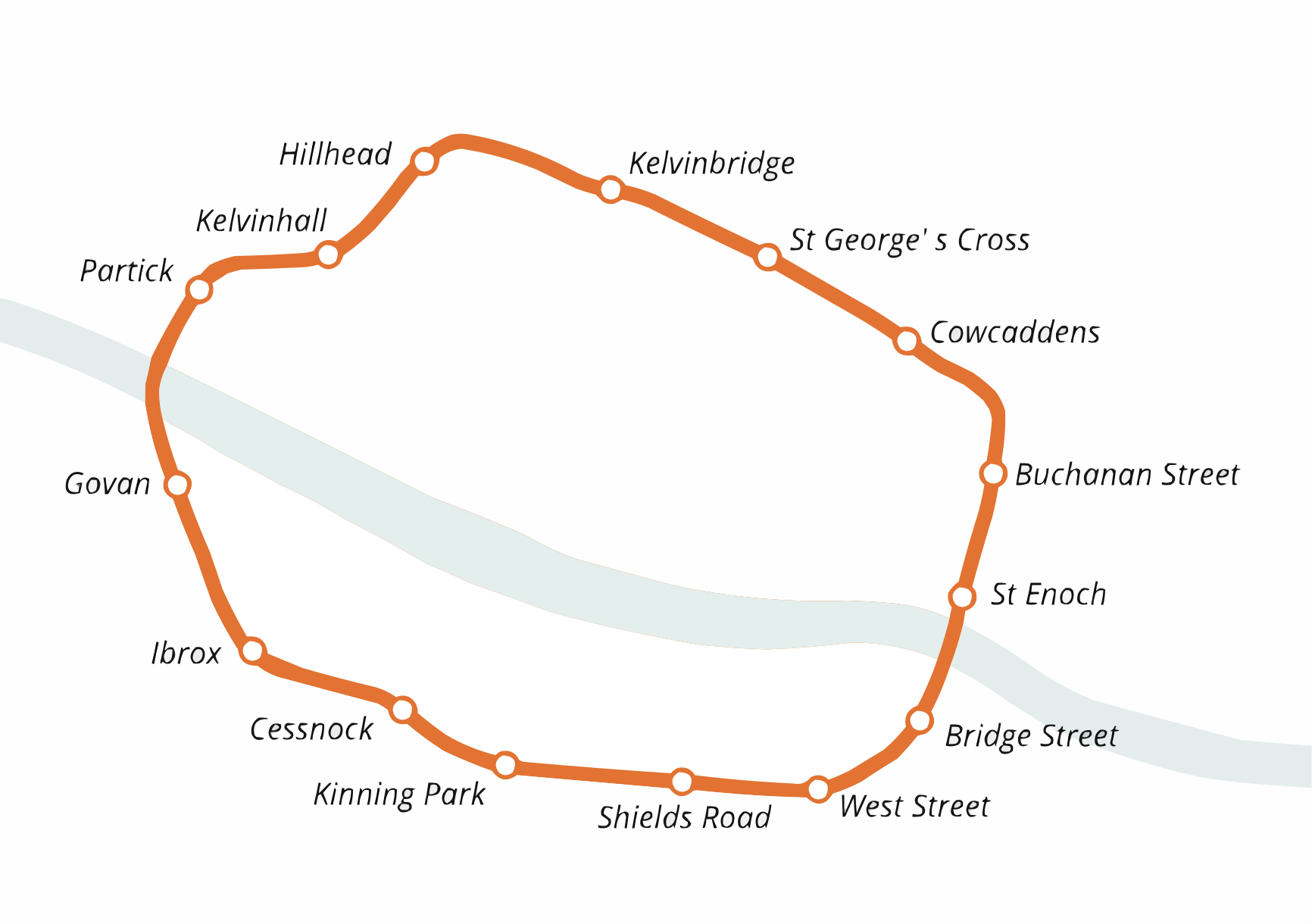Glasgow Subway

The Glasgow Subway is a metro system in Glasgow, Scotland. Opened in 1896, it is the third oldest subway system in the world after the London Underground and the Budapest Metro. Originally a cable railway, but later electrified, the Subway has only one circular line; it has not been expanded since it was opened. Between 1936 and 2003 it was officially called the Glasgow Underground (and indeed is still referred to as ‘the Underground’ by many locals), but the official name has now reverted back to Subway. It remains one of only two underground railways in the UK outside London, the other being the Tyne and Wear Metro. Unlike the London Underground, Glasgow Subway is not policed by British Transport Police.
The circular route is slightly less than 6.5 miles (10.4 km) long, and extends both north and south of the River Clyde. The tracks have the unusual narrow gauge of four feet (1.22 m), and the tunnel diameter of 11 feet (3.35 m) is considerably smaller than on the London Underground. It is one of the few long-lived metro systems that have never expanded from its original route, although a £40,000 study is currently in progress to examine the feasibility of an expansion into the city’s south side [1].
The subway is not the oldest underground railway in Glasgow itself; that distinction belongs to a 5-km stretch of the North Clyde line of the suburban railway network which runs in a sub-surface tunnel under the city centre between High Street and Charing Cross.
The subway’s running lines are entirely underground, but the maintenance depot at Broomloan Road (located between the Govan and Ibrox stations) is above ground, as was the earlier depot, also at Govan. Trains used to be hoisted on to and off of the tracks prior to the installing of electric systems and consequently points between Govan and Ibrox where trains can exit the underground tunnel system to terminate for engineering, cleaning or storing.
The system is owned and operated by the Strathclyde Partnership for Transport, formerly Strathclyde Passenger Transport, and typically carries between 13.3 and 14.7 million passengers per year.
History

As built and opened on 14 December 1896 by the Glasgow District Subway Company, the subway was powered by a clutch and cable system, with one cable for each direction. Rather than installing an additional cable to allow trains to reach the depot, they were transferred to and from the running lines by crane; this also meant that the two tracks could be completely separate, with no points anywhere. The city took over the company in 1923, and in 1935 the existing trains were converted to electric power delivered by a third rail. From March to December 1935, clockwise trains were cable-powered while counter-clockwise ones were electric.
Following the Beeching Axe of the 1960s, both St Enoch and Buchanan Street mainline stations were closed and subsequently demolished. This left a lasting legacy for the Subway, since it was left with no direct passenger connection to the national railway network - a major weakness which exists to the present day, although an interchange to the suburban rail system exists at Partick, and a moving walkway was installed between Buchanan Street station and Queen Street mainline station as part of the late 1970s modernisation.
The original rolling stock, thus converted, ran until 1977 when the system was shut down for a major refurbishment and modernisation. Badly deteriorated tunnels were repaired, stations were enlarged, heavier track was installed, the new Broomloan Road depot was built along with connecting tracks (with points) to replace the crane transfer, and new electrical supply from Westinghouse Electric Corporation was installed. The line reopened in 1980, using new rolling stock by Metro Cammell with GEC electric motors.
Prior to the modernisation, the stations had a unique earthy smell. The backs of the seats were attached to the sides of the carriages, which moved semi-independently from the floor (to which the seats themselves were attached), leading to passengers being rocked forwards and backwards as the carriage ‘shoogled’ passengers around.
Glasgow’s Museum of Transport has an area dedicated to the subway, with models showing the operation of the clutch and cable system, as well as a full scale replica of part of a subway station, complete with different rolling stock of the pre-modernisation era.
Future development
The system is unique compared to other metro systems as it has never been expanded from its original route, although ambitious plans were unveiled during 2005. Many schemes for extending the system have been proposed but none has come to fruition owing to the technical problems — tunnelling beneath the city is difficult owing to its geology, which is composed of solid rock and abandoned mineshafts making underground construction hazardous and expensive.
In Spring 2005, SPT announced that they would employ consultants to look into extending the system in the West End, East End, Southside and Glasgow Harbour areas of the city. The extension will take advantage of existing unused tunnels underneath the city, and there is a possibility that roads will be dug up to install tunnels before being replaced and resurfaced. The plans are expected to take twelve years to come to fruition. In the mean time there are plans to replace the fleet of trains and to install new electronic destination signs in stations.
At the moment, the Partick Interchange project is under way which will result in a complete re-development at the station which hosts a rail station, a subway station and a bus terminal on the outside.
Should the long-awaited Glasgow Crossrail project get the green light, then West Street station will be redeveloped as an interchange between the new surface railway and the Subway. This is projected to be completed by 2010, if funding is made available.
Connections
The underground has passenger links to the main railway system at two locations — at Partick, the system connects with the North Clyde line and Argyle lines of the Glasgow suburban railway network, and Buchanan Street station is connected to Queen Street main-line station by a moving walkway. Glasgow Central station and Argyle Street railway station (for the Argyle Line) are both a short walk from St. Enoch, and most stations connect with bus routes.
Stations

The stations on the underground, in clockwise order from the northernmost, are:
- Hillhead — Serves the University of Glasgow, Glasgow Botanic Gardens and BBC Scotland
- Kelvinbridge — For Great Western Road and Kelvingrove Park
- St. George’s Cross
- Cowcaddens
- Buchanan Street — connects to Glasgow Queen Street Station via travelator
- St Enoch — short walk to Glasgow Central Station and Argyle Street railway station
- Bridge Street
- West Street
- Shields Road
- Kinning Park
- Cessnock — Serves the Glasgow Science Centre, the Glasgow Tower and the IMAX cinema
- Ibrox — serves Ibrox stadium (named Copland Road before modernisation)
- Govan (named Govan Cross before modernisation)
- Partick (replaced the pre-modernisation Merkland Street station; the old station is slightly to the south-west of the current one)
- Kelvinhall (named Partick Cross before modernisation)
Hillhead, Buchanan Street, and St Enoch are the busiest stations; some of the stations south of the Clyde are very quiet. Ibrox is very busy during Rangers’ home football games, and on match days there are signs at the stations warning passengers when to avoid football related congestion.
Subcrawl
A subcrawl is a favourite pastime for Glasgow students. It is a pub crawl using the subway to move from pub to pub. The nearest pub to each station must be visited, leading to a total of (at least) fifteen drinks consumed. See binge drinking.
On a similar theme is the more traditional ‘Half & Half Tour’, referenced in Iain Banks’ novel Espedair Street, where the participants must consume one measure of whisky and half a pint of ‘Heavy’ (80/- ale) in each establishment visited.
Nicknames
It is said, but mainly by the media, to be nicknamed the ‘Clockwork Orange’ (coined from the title of the book and film A Clockwork Orange) because most of its carriages were painted orange, the then corporate colour of Strathclyde Passenger Transport, although these have since been replaced with a new colour scheme of carmine and cream with a thin orange band.
While the ‘Clockwork Orange’ nickname is often referred to in tourist guidebooks and local literature, most Glaswegians tend to refer to the system by its historic name — ‘Subway’, although it is often called either ‘the Underground’ or ‘the Tube’ in colloquial conversation.
See also
External links
- Strathclyde Partnership for Transport — Subway
- Photographs of Glasgow’s rolling stock
- Article and photo gallery about the Merkland Street station (now Partick)
- Collection of Google Earth locations of SPT Subway stations (Requires Google Earth software) from the Google Earth Community forum.
